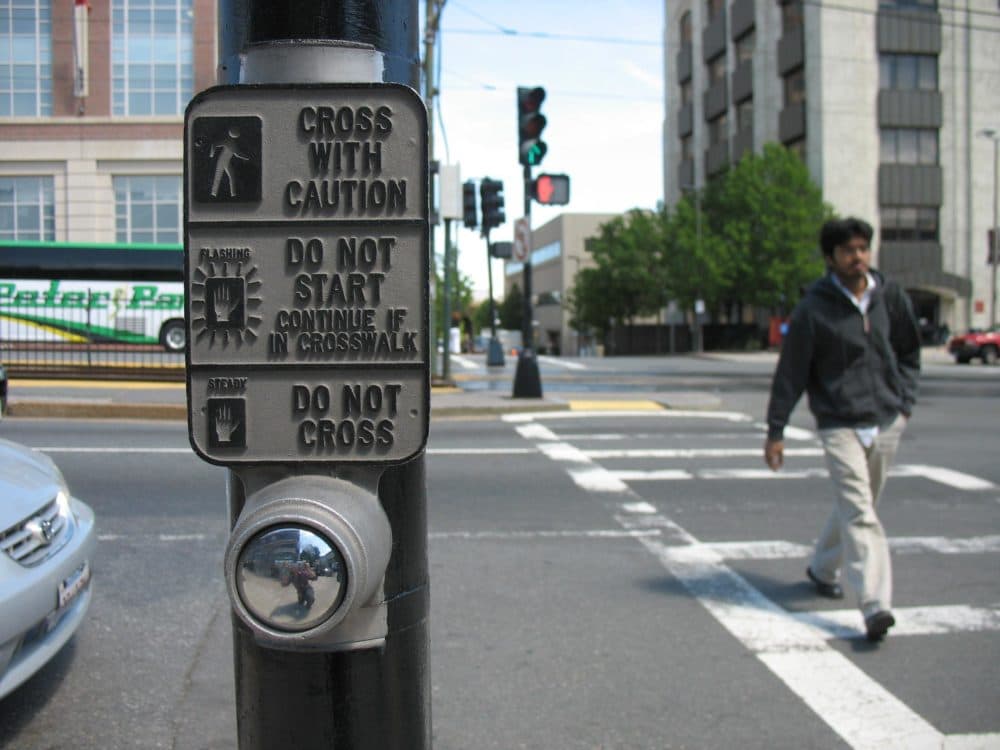Advertisement
Crosswalk Buttons Don't Do Anything! Except When They Do

When you’re waiting to cross the street, do you press that little button to request a walk sign? I do, but I’ve always been suspicious of it, especially in Boston.
The buttons around here (you know, the spherical metal knobs) always feel broken to me; not very springy and always a little out of alignment in the socket. And of course, they don’t beep or light up or do anything else to visibly register your input.
Sure, I eventually get a walk sign, but I feel like I usually do even when I don’t hit the button.
So, does the button do anything or not? I asked John DeBenedictis, director of engineering at the Boston Transportation Department, and the answer is surprisingly complicated. It all depends on when and where you hit that button.
"Downtown district, Back Bay, Beacon Hill, et cetera ... Financial District. Most of them are automatically set for pedestrian call during the hours of 7 a.m. to 7 p.m.,” DeBenedictis told me.
That means the pedestrian walk signal is automatically part of the traffic light cycle during those hours. If you've ever frantically flipped the button on the way to your noon meeting at the Hancock Tower, you were wasting calories, my friend.
"It's not going to hurt anything,” he said. “But it's not going to put a call in, because the call has been automatically made through our traffic signal control system."
What’s more, the system governs every single intersection in the city independently. Each one has its own rules.
[googlemap title="WBUR Map: Boston's 'Placebo' Crosswalk Buttons"]http://maps.google.com/maps/ms?ie=UTF8&hl=en&msa=0&msid=118366230091007475545.0004861b1601b14fcd83c&ll=42.353724,-71.073132&spn=0.0444,0.108147&z=13&output=embed[/googlemap]
Advertisement
Over at the corner of Massachusetts Avenue and Beacon Street, the pedestrian buttons are ineffective between 7 a.m. and 6 p.m. Monday through Friday, and 9 to 6 on the weekends. At the corner of Washington and Newton in the South End, the buttons don't do anything until after 11 at night. At Stuart and Dartmouth in the Back Bay, the buttons never do anything. Ever. Neither do the ones at Mass. Ave and Columbus, or Dartmouth and Huntington.
So, why not just leave the button on all the time?
"It's a numbers game,” DeBenedictis told me. “We know that there are going to be pedestrians at virtually every single cycle during the day (at certain intersections),” so he figures it's more convenient to just put the signals on an automatic cycle, and turn the buttons off. People get a walk sign whether they ask for it or not.
Logical as this system may sound, it drives some people crazy, like my friend Ken Kruckemeyer, transportation consultant and a longtime booster of biking and walking.
"The cars don't have to push a button,” he told me. “They're automatically acknowledged by the system to have a right to go when it's their turn. People ought to be given that option also."
To illustrate his point, Kruckemeyer took me to his most hated intersection in all of Boston: the corner of Park and Tremont streets, right outside Park Street Station. When we met there during a recent evening rush hour, the walk button on the southeast corner of the intersection was hidden behind newspaper boxes, and no one seemed to be looking for it.
“It probably shows that people have learned here that pushing the button doesn't make a darn bit of difference,” Kruckemeyer said. “And that's one of the really confusing things in Boston. Sometimes it does make a difference; you'll never get a walk light unless you push it. So, we have all kinds of different things going on but there's no feedback from the button that tells you anything so you know what to do."
All over the country, pedestrian advocates like Kruckemeyer have been opposed to these buttons for years, not just because they can be confusing. These groups argue that a button functions as a placebo: Like a little stress toy, it provides a place for walkers to channel their frustrations as they wait ... and wait.
This leads me to the real reason Ken Kruckemeyer hates the intersection of Park and Tremont. "93 percent of the time you're faced with a 'don't walk' sign, or a flashing 'don't walk,'” he said.
The traffic light cycle there is 100 seconds, which is a little long for a downtown intersection in a city like Boston. (Most of the cycles in Manhattan last 90 seconds, and cycles in Philadelphia are usually 60.)
Kruckemeyer and I waited for our walk sign, and almost as soon as we started to cross, the pedestrian signal started flashing "Don't Walk."
This is one of the busiest intersections in the city for pedestrians, with about 20,000 Red and Green Line riders popping down to the T station everyday. And even with the walk signal on an automatic cycle—which is supposed to help walkers—pedestrians only get a seven-second walk sign, followed by an 11-second flashing "Don't Walk." Cars get the remaining 82 seconds all to themselves.
These groups argue that a button functions as a placebo: Like a little stress toy, it provides a place for walkers to channel their frustrations as they wait ... and wait.
Kruckemeyer says the long light cycle, tiny walk period, and iffy pedestrian buttons make this intersection and dozens like it in Boston the worst of all worlds for pedestrians.
But as is so often the case, everything is different on the other side of the river.
In Cambridge, a walk button will always "make sure that the walk phase that you're asking for doesn't get skipped," Cambridge transportation director Susan Clippinger told me.
Clippinger’s office is around the corner from my place in Central Square, and when we went for a walk the other day we actually had trouble finding a pedestrian button to talk about.
"Generally we try not to do the button," she said. "The button is a thing that allows you to give vehicles more time."
And prioritizing vehicles is not what they’re all about in Cambridge.
What they are all about is keeping the whole light cycle brief. So, you may still get a really short walk sign like the one that annoys Ken Krukemeyer over by Park Street, but at least you'll get it more often.
"So we're not being pedestrian-friendly by necessarily making a walk long longer than it needs to be,” Clippinger said. “What we're doing is trying to make the time when you can't walk shorter, because that's the time when it's most annoying."
I told Radio Boston host Meghna Chakrabarti about all this as we waited to cross the street at the corner of Longwood and Brookline Ave.
“It's during that annoying time when I and, I suspect, many other Bostonians start to contemplate committing a crime,” she says.
Jaywalking?
“Yes," she says. "And now when I'm in downtown Boston, I'm never going to know if pressing the walk button did anything, so I'll feel like I have no choice but to take matters into my own hands.”
Herein lies one of the arguments against pedestrian buttons, especially buttons that are only effective some of the time. The theory goes: Any time people feel like they don’t understand the system, they’re more likely to give up on the system and cross whenever they can, walk sign or not.
